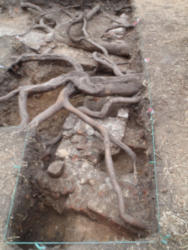19 Jul 2018
Forty Hall Summer Dig - Day 8

It was another day of pleasant surprises in the grounds of Forty Hall today, as we continue to uncover the features defining the buildings belonging to the service ranges of Henry VIII's Elsyng Palace.
In trench one, we excavated the small extension we started late yesterday, aiming to follow the external facade wall (centre of picture), which defines the south side of the 'boiling house' building containing the large circular furnace.
As we had half suspected, we found the wall continues a short distance east before it is truncated by the substantial demolition cut that runs north-south through this part of the site.
We think it very likely that this cut was made to remove the east-end wall of the building during demolition, and since it has removed the east end wall completely we will probably never know exactly how far east the building extended, but it can't have been very far from the point the wall was truncated.

Meanwhile, we continued to excavate the loose rubble fill of the furnace's flue. The neck of the furnace is now well defined and the beginning of the flue has straight brick sides. The loose rubble fill includes some large brick and tile fragments with large pieces of mortar adhering to them - some of these joints are wedge shaped which is strong evidence that the structure they once belonged to was arched or domed.
Brick fragments lower in the fill also show signs of soot blackening, which again reinforces our theory that the flue had an arch made of a combination of brick and tile.
We have stopped just short of removing all the rubble in the furnace itself and also in the flue, leaving a few centimetres covering the next context, which we know from last year's work will be a layer of ash, deposited during the furnace's last firing more than four centuries ago.

We will probably excavate this context tomorrow, and hope that it produces some dating evidence - finds, especially from the furnace, have been more scarce today.
Late in the afternoon, while removing rubble from the wall forming the west front of the furnace (pictured), we were surprised to find a sizeable void protruding into the furnace's base.
The void is rectangular and was partly blocked by a loose group of complete bricks from the rubble fill, all of which were partly soot-blackened.
We've not had a chance to study it yet, but by reaching in with a camera we got a preview shot (pictured) which shows it is at least three courses deep and partly filled by the rubble context. As far as we can see it doesn't go through to the furnace -- we'll have to wait till the rubble context is fully excavated before we can find out any more, but it suggests that the construction of the furnace may be more complex than it looks!

Speaking of complexity, the far west end of trench one continued to be the source of much head scratching today, as we continued to excavate the odd alcove in what we thought would be a simple interior partition wall.
The alcove's brick floor only extends as far as the front of the main wall, and together with the fact that the alcove is rendered, and faint signs of a rebate in the floor, perhaps for a timber frame or doors, leads us to believe it is probably the remains of a cupboard, similar to one recorded on the site by the Society in 1967.

On the north side of the cupboard, the wall seems to turn a corner and has a small wall projecting to the west (click image for annotations), which is difficult at the moment to interpret but we suspect may be the base of a large column -- the furnace room would have probably spanned two storeys and may have needed extra structural support.
The tangle of roots is starting to slow work down in this trench but there shouldn't be much more to do (provided nothing more unexpected turns up!).
The main remaining job is to find the edge of the furnace's ash pit, and we may have just started to find evidence of an ash layer emerge in part of the trench -- again, excavating that is a job for tomorrow.

Trench two, meanwhile, is almost fully excavated and there remains only a few recording jobs to to before it can be backfilled. A small extension to the north revealed more of the roof-tile capped internal wall we've seen earlier in the week and more of the multiphased herringbone brick floors that characterise the building.
Interestingly, an area of the floor in this trench has noticeably slumped and at a later date been partially filled with a rammed chalk deposit -- perhaps a crude attempt at levelling the surface -- but if the floors were liable to slump like this, it may explain the sequence of laying and re-laying floors we've seen nearby.
You can explore the rest of trench two, as it was when we photographed it yesterday, at Sketchfab - see below.
Hopefully, by the end of the week, we should be able to produce a similar model of our furnace.